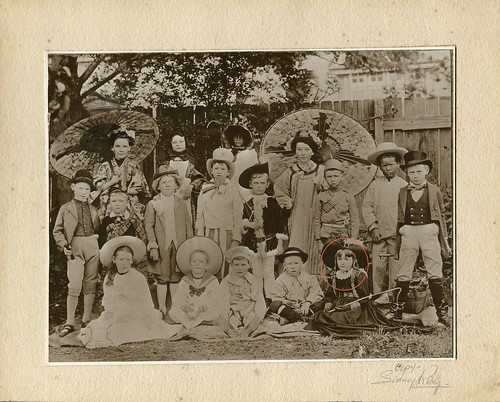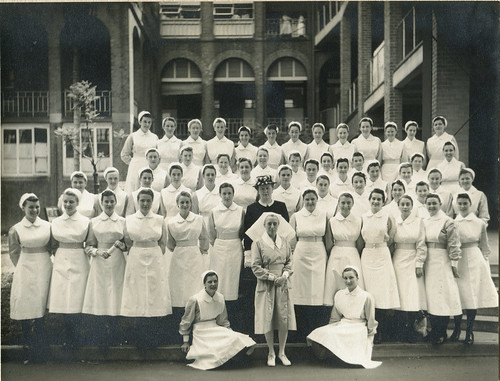Originally the "uniform" of this post was the khaki kind. Given the proud involvement of Cam and various members of his family, both past and present, in the military I planned to provide some history for you all. But plans changed when this post just dropped in my lap, as the saying goes.
The uniform now the subject of this post is white - or rather blue and white striped (see below)!
Not only do we have four generations wearing khaki in the family, there are three generations wearing the white of registered nurses. To celebrate our most recent generations' progression through their training, Didi was asked to share her recollection of her training. In her own words...
NURSING TRAINING AT R.P.A FROM 31 JANUARY
1944 – 1948
I had come from Stoneleigh, my parents’ home at Ando, on 30th January a
very excited 19 year old to begin a career I had wanted to start for years!
I well remember my Uncle Archie, a dear man,
quite old and not driving any more, offering to take me out to RPA the next
day. Bless his heart, he and I carried my huge suitcase with a walking stick
through the handle by train all the way to the Hospital! We were to start at
the Preliminary Training School the next day (alias PTS).
As World War II had not finished and the
American soldiers were still in the Nurses’ Home and various other parts of RPA
as well, we were to be lodged in a block of units in Summer Hill, a suburb not
far away, and commute daily to the Hospital by train morning and evening. What
a blow!
We soon settled in to lectures and hands on
practice with dummies or other nurses for patients!! We soon learned how to
take temperatures, take a pulse rate and how to bathe patients in bed. To do so
we had to find a basin, fill it with water and sponge the patient with a warm
washer – hands, arms, torso, as far as “possible”. Then hand them the washer
for them to wash “possible” themselves! We also had to “rub a back” to avoid
bedsores, “carbolise a bed”, clean a bedside locker, make beds with top sheet
turned down to an exact measurement, give an injection etc etc.
Six weeks later we graduated from PTS and
were to start real nursing in the wards. First of all we were housed in huts
specially built for us as the soldiers were still in large parts of the Hospital.
These were rather crude and small but we didn’t mind – we were about to start
real nursing.
My first ward was a Men’s Medical with rather
sick patients. Two new nurses went together to our first ward. There I saw my
first “Red Cross”, a man had died. It was very emotional but we soon learned
with a senior nurse how to lay out a body and prepare it to go to the Hospital
Morgue.
 In First Year we were called “Probationers”.
Our uniforms were blue/white striped dresses, our white caps had to cover all
the hair on our heads which was very difficult with long blonde hair. We had
one star on our caps to denote First Year and each year gained another star. We
didn’t get our white aprons till much later and stiff cuffs and belts and that
was what we wore for the 4 years, with black stockings.
In First Year we were called “Probationers”.
Our uniforms were blue/white striped dresses, our white caps had to cover all
the hair on our heads which was very difficult with long blonde hair. We had
one star on our caps to denote First Year and each year gained another star. We
didn’t get our white aprons till much later and stiff cuffs and belts and that
was what we wore for the 4 years, with black stockings.
We felt we had good training as we were sent
to a different type of ward every few months including Theatres and Psychiatry,
Neurosurgery, Children’s, Central and Dressings Autoclaving.
We were also very disciplined. If Matron
came into a ward to ‘do rounds’, we had to quickly take off our cuffs, put them
under our apron and with hands behind our backs say “Good Morning Matron” and
wait till she had finished doing rounds with the Ward Sister and we were
dismissed!!
Most of our intake of 32 girls was from the
country – only a few were city girls and as we had very little money to go into
town to shop on our time off we made very good friends with each other. Those
friendships have weathered 68 years and the few of us left meet regularly to
lunch in the city. We have minded each others’ babies while new ones were
coming and our children are friends and so we cherish all that.
During our training we were in the wards by
5am to make beds and get our patients ready for the day. We usually had a 4
hour pass most days: 9am - 1pm or 10am – 2pm. Some slept through it but
sometimes I would get on a tram to the city just to look around!! Evening duty
was 1 or 2pm – 7:30pm. Night duty 8pm – 7am for several weeks.
Our final exams took place in the Great Hall
at Sydney University, not far from RPA. When our results were out we had a Ball
(where Jim and I, having that day bought a ring, felt we were engaged though I
couldn’t wear it on duty – I had it on a string around my neck!).
Soon after we knew we would be called to
Matron’s Office to find out results and be told where we would go as Junior
Sisters with Veils.
I was very surprised to find out I had been
2nd in NSW in my Practical Nursing Exam so Matron wanted me to teach
in PTS. With great courage I declined that posting and was sent to King George
Hospital, the Gynae and Obstetric part of RPA.
It was the happiest time of my career as my
job was to admit patients for surgery, take their history and when they were taken
to Theatres I would assist the surgeon and get to know what they had had removed
or otherwise tampered with so I could know how to nurse them through their time
in Hospital. I stayed there about 18 months, went home to Ando for a time and
was married in 1949.
After a time I did some local nursing in
patients’ homes and also a while at a Hospital in Gordon owned by a nurse who
had been Senior to me and loved to have PA girls on her staff!
After that no more nursing, just babies but
I ran a Dental Clinic at the Spastic Centre for 12 years!!
Melodie and Skye, I hope your careers will
be as happy as mine was. I am so proud of you both and what you have already
achieved and thrilled to have 2 more “Sisters” in my extended family.
All my love,
Didi




































